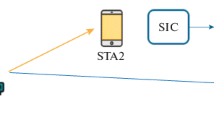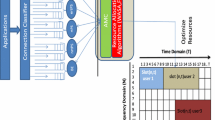Abstract
Uplink Non-Orthogonal Multiple Access (UL NOMA) is a promising technology that can improve the spectral efficiency and bandwidth of Wi-Fi networks. The use of UL NOMA allows multiple stations to transmit data to an access point in the same frequency–time resource. Reservation signals are used to organize UL NOMA data transmission. In this paper, we develop an analytical model that makes it possible to evaluate the performance of UL NOMA with a high accuracy at various Wi-Fi network parameters.






Similar content being viewed by others
REFERENCES
CISCO (2020). Cisco Annual Internet Report (2018–2023), White Paper.
E. Khorov, A. Kureev, I. Levitsky, and I. F. Akyildiz, “Prototyping and experimental study of non-orthogonal multiple access in Wi-Fi networks,” IEEE Network 34 (4), 210 –217 (2020).
E. Khorov, A. Kureev, I. Levitsky, and I. F. Akyildiz, “A phase noise resistant constellation rotation method and its experimental validation for NOMA Wi-Fi,” IEEE J. Selected Areas Commun. 40, 1346–1354 (2022).
E. Endovitskiy, A. Kureev, I. Levitsky, S. Tutelian, E. Khorov, “Performance evaluation of downlink non-orthogonal multiple access in Wi-Fi networks,” J. Commun. Technol. Electron. 66, 1485–1490 (2021).
R. Zlobin, A. Kureev, and E. Khorov, “Receiver design and frame format for uplink NOMA in Wi-Fi,” in IEEE INFOCOM 2022—IEEE Conf. on Computer Communications Workshops (INFOCOM WKSHPS) (IEEE, New York, 2022).
H. S. Ghazi and K. Wesolowski, “Uplink NOMA scheme for Wi-Fi applications,” Int. J. Electron. Telecommun. 64, 481–485 (2018).
H. Zhang, D. Zhang, W. Meng, and C. Li, “User pairing algorithm with SIC in non-orthogonal multiple access system,” in 2016 IEEE Int. Conf. on Communications (ICC), (IEEE, New York, 2022), pp. 1–6.
B. S. Pavan and V. P. Harigovindan, “A novel channel access scheme for NOMA based IEEE 802.11 WLAN,” (IEEE, 2021).
G. Korolev, A. Kureev, E. Khorov, and D. Shmelkin, “Performance evaluation of Uplink NOMA in Wi-Fi networks,” in Proc. Int. Conf. Engineering and Telecommunication (En&T), Nov. 2020 (IEEE, New York, 2020), pp. 1–5.
G. Korolev, A. Kureev, E. Khorov, and A. Lyakhov, “Enabling synchronous uplink NOMA in Wi-Fi networks,” in Proc. Int. Conf. Engineering and Telecommunication (En&T), Nov. 2021 (IEEE, 2021), pp. 1–5.
E. Khorov, A. Kiryanov, A. Lyakhov, and G. Bianchi, “A tutorial on IEEE 802.11 ax high efficiency WLANs,” IEEE Commun. Surveys & Tutorials 21, 197–216 (2018).
Simone Merlin, G. Barriac, H. Sampath, L. Cariou, and T. Derham, “TGax simulation scenarios,” IEEE802, 2015.
G. Bianchi, “Performance analysis of the IEEE 802.11 distributed coordination function,” IEEE J. Select. Areas in Commun. 18, 535–547 (2000).
Funding
The work was supported by the Russian Science Foundation, project no. 21-19-00846, https://rscf.ru/en/project/ 21-19-00846/.
Author information
Authors and Affiliations
Corresponding authors
Ethics declarations
The authors declare that they have no conflicts of interest.
Additional information
Translated by A. Ivanov
Rights and permissions
About this article
Cite this article
Korolev, G.S., Kureev, A.A., Lyakhov, A.I. et al. Performance Evaluation of Uplink Non-Orthogonal Multiple Access with Reservation Signals in Wi-Fi Networks. J. Commun. Technol. Electron. 67, 1513–1520 (2022). https://doi.org/10.1134/S1064226922120105
Received:
Revised:
Accepted:
Published:
Issue Date:
DOI: https://doi.org/10.1134/S1064226922120105




